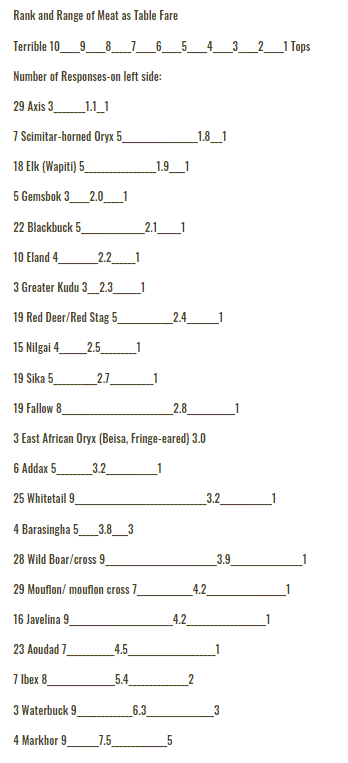Texotic Tables Meats Ranked as Table Fare
Compiled for the Exotic Wildlife Association members by Elizabeth Cary Mungall,
EWA Wildlife Research Consultant
(Chart Below Text)
With interest growing in the possibilities of exotics as non-traditional livestock, meat value of the various species has come under study. Preliminary investigations have pointed to low cholesterol, low fat and low calorie count for a selection of exotics like axis, blackbuck, sika and nilgai that are present on Texas rangeland in harvestable numbers. For lasting success as a marketable commodity, exotics’ meat also has to taste good. To get an idea about acceptability on the table, the Exotic Wildlife Association put out a survey among members and their friends. Each of the 35 people responding rated the exotics’ meats that he or she had eaten. For comparison, 3 native species commonly hunted in Texas were also listed on the form.
Survey results demonstrate the general consensus that axis is tops. Axis had the most responses, and the only vote less than “excellent” was a single “good.” Of the common exotics, blackbuck came next. The gap between it and axis points up the extreme leanness of many exotics’ meats, a characteristic that can lead to complaints about dryness unless compensated for by adding fat or by using moist heat when cooking. Eland, one of the few wild species that has marbling similar to beef, comes next. It is lean relative to the nilgai, the only numerous exotic large enough to offer a big carcass. Coming soon after, on its heels, are sika and fallow, always a close pair. Sika is lauded among the comments for a “rich, gamey taste Europeans like.” Fallow is the northern staple for deer farming where tasty tropical species like axis cannot manage.
Comments with hogs, sheep, aoudad and ibex emphasize that young animals may rate good to excellent while adults only score fair to good. With all ages averaged together, European wild boar still leads hogs of mixed characteristics by 3.5 to 4.5 on the 1 to 10 scale (1 = best). Both mouflon and its Corsican crosses rank 4.2, partly a reflection of the Texas bias against domestic lamb in some circles.
The white-tailed deer, Texas’s primary native game, is the only animal getting the whole range of responses from “the best I’ve eaten” to “the worst I’ve eaten” – sometimes both extremes from the same people. Here handling as well as sex, age, diet and season are mentioned. Doubtless these considerations affect other eating experiences also. And even with inherently coarse or tough meats like waterbuck or barasingha, careful preparation in the kitchen can often give pleasing results. This helps many meats that got low votes and low averages to win high votes also. So don’t shy away from exotics meats. Happy eating!

